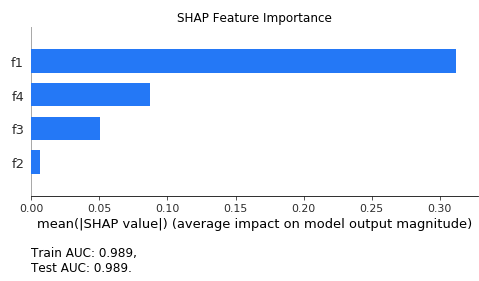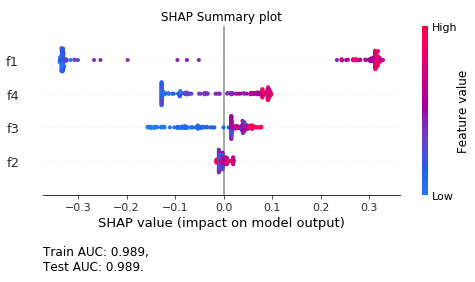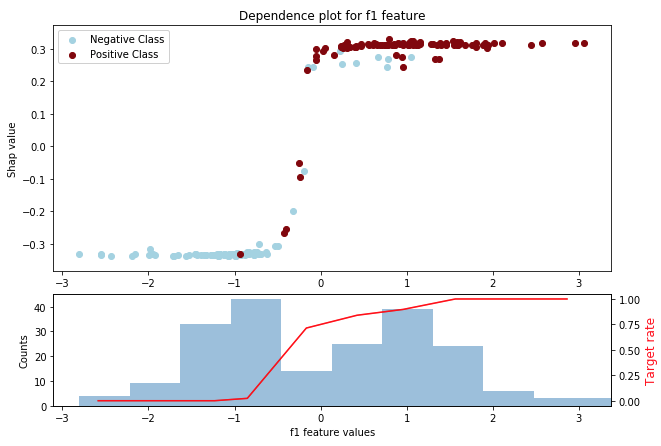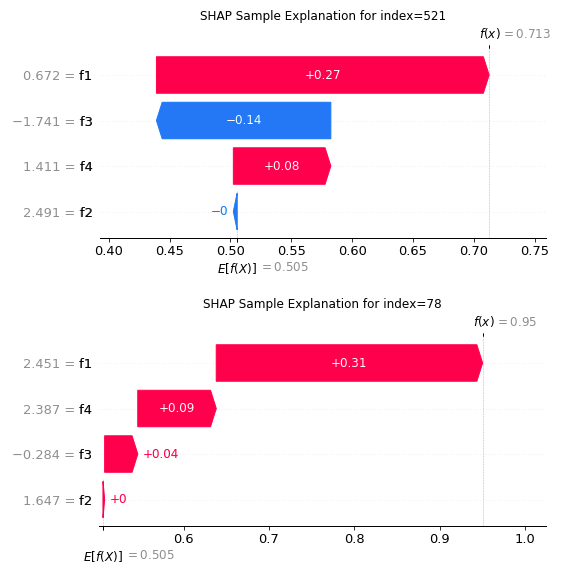Model Interpretation using SHAP
The aim of this module is to provide tools for model interpretation using the SHAP library. The class below is a convenience wrapper that implements multiple plots for tree-based & linear models.
ShapModelInterpreter
Bases: BaseFitComputePlotClass
This class is a wrapper that allows to easily analyse a model's features.
It allows us to plot SHAP feature importance, SHAP summary plot and SHAP dependence plots.
Example:
from sklearn.datasets import make_classification
from sklearn.ensemble import RandomForestClassifier
from sklearn.model_selection import train_test_split
from probatus.interpret import ShapModelInterpreter
import numpy as np
import pandas as pd
feature_names = ['f1', 'f2', 'f3', 'f4']
# Prepare two samples
X, y = make_classification(n_samples=5000, n_features=4, random_state=0)
X = pd.DataFrame(X, columns=feature_names)
X_train, X_test, y_train, y_test = train_test_split(X, y, test_size=0.2, random_state=42)
# Prepare and fit model. Remember about class_weight="balanced" or an equivalent.
model = RandomForestClassifier(class_weight='balanced', n_estimators = 100, max_depth=2, random_state=0)
model.fit(X_train, y_train)
# Train ShapModelInterpreter
shap_interpreter = ShapModelInterpreter(model)
feature_importance = shap_interpreter.fit_compute(X_train, X_test, y_train, y_test)
# Make plots
ax1 = shap_interpreter.plot('importance')
ax2 = shap_interpreter.plot('summary')
ax3 = shap_interpreter.plot('dependence', target_columns=['f1', 'f2'])
ax4 = shap_interpreter.plot('sample', samples_index=[X_test.index.tolist()[0]])




Source code in probatus/interpret/model_interpret.py
19 20 21 22 23 24 25 26 27 28 29 30 31 32 33 34 35 36 37 38 39 40 41 42 43 44 45 46 47 48 49 50 51 52 53 54 55 56 57 58 59 60 61 62 63 64 65 66 67 68 69 70 71 72 73 74 75 76 77 78 79 80 81 82 83 84 85 86 87 88 89 90 91 92 93 94 95 96 97 98 99 100 101 102 103 104 105 106 107 108 109 110 111 112 113 114 115 116 117 118 119 120 121 122 123 124 125 126 127 128 129 130 131 132 133 134 135 136 137 138 139 140 141 142 143 144 145 146 147 148 149 150 151 152 153 154 155 156 157 158 159 160 161 162 163 164 165 166 167 168 169 170 171 172 173 174 175 176 177 178 179 180 181 182 183 184 185 186 187 188 189 190 191 192 193 194 195 196 197 198 199 200 201 202 203 204 205 206 207 208 209 210 211 212 213 214 215 216 217 218 219 220 221 222 223 224 225 226 227 228 229 230 231 232 233 234 235 236 237 238 239 240 241 242 243 244 245 246 247 248 249 250 251 252 253 254 255 256 257 258 259 260 261 262 263 264 265 266 267 268 269 270 271 272 273 274 275 276 277 278 279 280 281 282 283 284 285 286 287 288 289 290 291 292 293 294 295 296 297 298 299 300 301 302 303 304 305 306 307 308 309 310 311 312 313 314 315 316 317 318 319 320 321 322 323 324 325 326 327 328 329 330 331 332 333 334 335 336 337 338 339 340 341 342 343 344 345 346 347 348 349 350 351 352 353 354 355 356 357 358 359 360 361 362 363 364 365 366 367 368 369 370 371 372 373 374 375 376 377 378 379 380 381 382 383 384 385 386 387 388 389 390 391 392 393 394 395 396 397 398 399 400 401 402 403 404 405 406 407 408 409 410 411 412 413 414 415 416 417 418 419 420 421 422 423 424 425 426 427 428 429 430 431 432 433 434 435 436 437 438 439 440 441 442 443 444 445 446 447 448 449 450 451 452 453 454 455 456 457 458 459 460 461 462 463 464 465 466 467 468 469 470 471 472 473 474 475 476 477 478 479 480 481 482 483 484 485 486 487 488 489 490 491 492 | |
__init__(model, scoring='roc_auc', verbose=0, random_state=None)
Initializes the class.
Parameters:
| Name | Type | Description | Default |
|---|---|---|---|
model
|
classifier or regressor
|
Model fitted on X_train. |
required |
scoring
|
string or Scorer
|
Metric for which the model performance is calculated. It can be either a metric name aligned with predefined classification scorers names in sklearn (link). Another option is using probatus.utils.Scorer to define a custom metric. |
'roc_auc'
|
verbose
|
int
|
Controls verbosity of the output:
|
0
|
random_state
|
int
|
Random state set for the nr of samples. If it is None, the results will not be reproducible. For reproducible results set it to an integer. |
None
|
Source code in probatus/interpret/model_interpret.py
63 64 65 66 67 68 69 70 71 72 73 74 75 76 77 78 79 80 81 82 83 84 85 86 87 88 89 90 91 | |
compute(return_scores=False, shap_variance_penalty_factor=None)
Computes the DataFrame that presents the importance of each feature.
Parameters:
| Name | Type | Description | Default |
|---|---|---|---|
return_scores
|
bool
|
Flag indicating whether the method should return the train and test score of the model, together with the model interpretation report. If true, the output of this method is a tuple of DataFrame, float, float. |
False
|
shap_variance_penalty_factor
|
int or float
|
Apply aggregation penalty when computing average of shap values for a given feature. Results in a preference for features that have smaller standard deviation of shap values (more coherent shap importance). Recommend value 0.5 - 1.0. Formula: penalized_shap_mean = (mean_shap - (std_shap * shap_variance_penalty_factor)) |
None
|
Returns:
| Type | Description |
|---|---|
DataFrame or tuple(DataFrame, float, float)
|
Dataframe with SHAP feature importance, or tuple containing the dataframe, train and test scores of the model. |
Source code in probatus/interpret/model_interpret.py
232 233 234 235 236 237 238 239 240 241 242 243 244 245 246 247 248 249 250 251 252 253 254 255 256 257 258 259 260 261 262 263 264 265 266 267 268 269 270 271 272 273 274 275 276 277 278 279 280 281 282 283 284 285 | |
fit(X_train, X_test, y_train, y_test, column_names=None, class_names=None, **shap_kwargs)
Fits the object and calculates the shap values for the provided datasets.
Parameters:
| Name | Type | Description | Default |
|---|---|---|---|
X_train
|
DataFrame
|
Dataframe containing training data. |
required |
X_test
|
DataFrame
|
Dataframe containing test data. |
required |
y_train
|
Series
|
Series of labels for train data. |
required |
y_test
|
Series
|
Series of labels for test data. |
required |
column_names
|
None, or list of str
|
List of feature names for the dataset. If None, then column names from the X_train dataframe are used. |
None
|
class_names
|
None, or list of str
|
List of class names e.g. ['neg', 'pos']. If none, the default ['Negative Class', 'Positive Class'] are used. |
None
|
**shap_kwargs
|
keyword arguments passed to
shap.Explainer.
It also enables |
{}
|
Source code in probatus/interpret/model_interpret.py
93 94 95 96 97 98 99 100 101 102 103 104 105 106 107 108 109 110 111 112 113 114 115 116 117 118 119 120 121 122 123 124 125 126 127 128 129 130 131 132 133 134 135 136 137 138 139 140 141 142 143 144 145 146 147 148 149 150 151 152 153 154 155 156 157 158 159 160 161 162 163 164 165 166 167 168 169 170 171 172 173 174 175 176 177 178 179 180 181 182 183 184 185 | |
fit_compute(X_train, X_test, y_train, y_test, column_names=None, class_names=None, return_scores=False, shap_variance_penalty_factor=None, **shap_kwargs)
Fits the object and calculates the shap values for the provided datasets.
Parameters:
| Name | Type | Description | Default |
|---|---|---|---|
X_train
|
DataFrame
|
Dataframe containing training data. |
required |
X_test
|
DataFrame
|
Dataframe containing test data. |
required |
y_train
|
Series
|
Series of labels for train data. |
required |
y_test
|
Series
|
Series of labels for test data. |
required |
column_names
|
None, or list of str
|
List of feature names for the dataset. If None, then column names from the X_train dataframe are used. |
None
|
class_names
|
None, or list of str
|
List of class names e.g. ['neg', 'pos']. If none, the default ['Negative Class', 'Positive Class'] are used. |
None
|
return_scores
|
bool
|
Flag indicating whether the method should return the train and test score of the model, together with the model interpretation report. If true, the output of this method is a tuple of DataFrame, float, float. |
False
|
shap_variance_penalty_factor
|
int or float
|
Apply aggregation penalty when computing average of shap values for a given feature. Results in a preference for features that have smaller standard deviation of shap values (more coherent shap importance). Recommend value 0.5 - 1.0. Formula: penalized_shap_mean = (mean_shap - (std_shap * shap_variance_penalty_factor)) |
None
|
**shap_kwargs
|
keyword arguments passed to
shap.Explainer.
It also enables |
{}
|
Returns:
| Type | Description |
|---|---|
DataFrame or tuple(DataFrame, float, float)
|
Dataframe with SHAP feature importance, or tuple containing the dataframe, train and test scores of the model. |
Source code in probatus/interpret/model_interpret.py
287 288 289 290 291 292 293 294 295 296 297 298 299 300 301 302 303 304 305 306 307 308 309 310 311 312 313 314 315 316 317 318 319 320 321 322 323 324 325 326 327 328 329 330 331 332 333 334 335 336 337 338 339 340 341 342 343 344 345 346 347 348 349 350 351 352 353 354 355 356 357 358 | |
plot(plot_type, target_set='test', target_columns=None, samples_index=None, show=True, **plot_kwargs)
Plots the appropriate SHAP plot.
Parameters:
| Name | Type | Description | Default |
|---|---|---|---|
plot_type
|
str
|
One of the following:
|
required |
target_set
|
str
|
The set for which the plot should be generated, either |
'test'
|
target_columns
|
None, str or list of str
|
List of features names, for which the plots should be generated. If None, all features will be plotted. |
None
|
samples_index
|
(None, int, list or Index)
|
Index of samples to be explained if the |
None
|
show
|
bool
|
If True, the plots are showed to the user, otherwise they are not shown. Not showing plot can be useful, when you want to edit the returned axis, before showing it. |
True
|
**plot_kwargs
|
Keyword arguments passed to the plot method. For 'importance' and 'summary' plot_type, the kwargs are passed to shap.summary_plot, for 'dependence' plot_type, they are passed to probatus.interpret.DependencePlotter.plot method. |
{}
|
Returns:
| Type | Description |
|---|---|
axes or list(axes)
|
An Axes with the plot, or list of axes when multiple plots are returned. |
Source code in probatus/interpret/model_interpret.py
360 361 362 363 364 365 366 367 368 369 370 371 372 373 374 375 376 377 378 379 380 381 382 383 384 385 386 387 388 389 390 391 392 393 394 395 396 397 398 399 400 401 402 403 404 405 406 407 408 409 410 411 412 413 414 415 416 417 418 419 420 421 422 423 424 425 426 427 428 429 430 431 432 433 434 435 436 437 438 439 440 441 442 443 444 445 446 447 448 449 450 451 452 453 454 455 456 457 458 459 460 461 462 463 464 465 466 467 468 469 470 471 472 473 474 475 476 477 478 479 480 481 482 483 484 485 486 487 488 489 490 491 492 | |
DependencePlotter
Bases: BaseFitComputePlotClass
Plotter used to plot SHAP dependence plot together with the target rates.
Currently it supports tree-based and linear models.
Parameters:
| Name | Type | Description | Default |
|---|---|---|---|
model
|
classifier for which interpretation is done. |
required |
Example:
from sklearn.datasets import make_classification
from sklearn.ensemble import RandomForestClassifier
from probatus.interpret import DependencePlotter
X, y = make_classification(n_samples=15, n_features=3, n_informative=3, n_redundant=0, random_state=42)
model = RandomForestClassifier().fit(X, y)
bdp = DependencePlotter(model)
shap_values = bdp.fit_compute(X, y)
bdp.plot(feature=2)

Source code in probatus/interpret/shap_dependence.py
9 10 11 12 13 14 15 16 17 18 19 20 21 22 23 24 25 26 27 28 29 30 31 32 33 34 35 36 37 38 39 40 41 42 43 44 45 46 47 48 49 50 51 52 53 54 55 56 57 58 59 60 61 62 63 64 65 66 67 68 69 70 71 72 73 74 75 76 77 78 79 80 81 82 83 84 85 86 87 88 89 90 91 92 93 94 95 96 97 98 99 100 101 102 103 104 105 106 107 108 109 110 111 112 113 114 115 116 117 118 119 120 121 122 123 124 125 126 127 128 129 130 131 132 133 134 135 136 137 138 139 140 141 142 143 144 145 146 147 148 149 150 151 152 153 154 155 156 157 158 159 160 161 162 163 164 165 166 167 168 169 170 171 172 173 174 175 176 177 178 179 180 181 182 183 184 185 186 187 188 189 190 191 192 193 194 195 196 197 198 199 200 201 202 203 204 205 206 207 208 209 210 211 212 213 214 215 216 217 218 219 220 221 222 223 224 225 226 227 228 229 230 231 232 233 234 235 236 237 238 239 240 241 242 243 244 245 246 247 248 249 250 251 252 253 254 255 256 257 258 259 260 261 262 263 264 265 266 267 268 269 270 271 272 273 274 275 276 277 278 279 280 281 282 283 284 285 286 287 288 289 290 291 292 293 294 295 296 297 298 299 300 301 302 303 304 305 306 307 308 309 310 311 312 313 314 315 316 317 318 319 320 321 322 323 324 325 326 327 328 329 330 331 332 333 334 335 336 337 338 339 340 341 342 343 | |
__init__(model, verbose=0, random_state=None)
Initializes the class.
Parameters:
| Name | Type | Description | Default |
|---|---|---|---|
model
|
model object
|
regression or classification model or pipeline. |
required |
verbose
|
int
|
Controls verbosity of the output:
|
0
|
random_state
|
int
|
Random state set for the nr of samples. If it is None, the results will not be reproducible. For reproducible results set it to an integer. |
None
|
Source code in probatus/interpret/shap_dependence.py
35 36 37 38 39 40 41 42 43 44 45 46 47 48 49 50 51 52 53 54 55 56 | |
__repr__()
Represent string method.
Source code in probatus/interpret/shap_dependence.py
58 59 60 61 62 | |
compute()
Computes the report returned to the user, namely the SHAP values generated on the dataset.
Returns:
| Type | Description |
|---|---|
DataFrame
|
SHAP Values for X. |
Source code in probatus/interpret/shap_dependence.py
112 113 114 115 116 117 118 119 120 121 | |
fit(X, y, column_names=None, class_names=None, precalc_shap=None, **shap_kwargs)
Fits the plotter to the model and data by computing the shap values.
If the shap_values are passed, they do not need to be computed.
Parameters:
| Name | Type | Description | Default |
|---|---|---|---|
X
|
DataFrame
|
input variables. |
required |
y
|
Series
|
target variable. |
required |
column_names
|
None, or list of str
|
List of feature names for the dataset. If None, then column names from the X_train dataframe are used. |
None
|
class_names
|
None, or list of str
|
List of class names e.g. ['neg', 'pos']. If none, the default ['Negative Class', 'Positive Class'] are used. |
None
|
precalc_shap
|
(Optional, None or array)
|
Precalculated shap values, If provided they don't need to be computed. |
None
|
**shap_kwargs
|
keyword arguments passed to
shap.Explainer.
It also enables |
{}
|
Source code in probatus/interpret/shap_dependence.py
64 65 66 67 68 69 70 71 72 73 74 75 76 77 78 79 80 81 82 83 84 85 86 87 88 89 90 91 92 93 94 95 96 97 98 99 100 101 102 103 104 105 106 107 108 109 110 | |
fit_compute(X, y, column_names=None, class_names=None, precalc_shap=None, **shap_kwargs)
Fits the plotter to the model and data by computing the shap values.
If the shap_values are passed, they do not need to be computed
Parameters:
| Name | Type | Description | Default |
|---|---|---|---|
X
|
DataFrame
|
Provided dataset. |
required |
y
|
Series
|
Labels for X. |
required |
column_names
|
None, or list of str
|
List of feature names for the dataset. If None, then column names from the X_train dataframe are used. |
None
|
class_names
|
None, or list of str
|
List of class names e.g. ['neg', 'pos']. If none, the default ['Negative Class', 'Positive Class'] are used. |
None
|
precalc_shap
|
(Optional, None or array)
|
Precalculated shap values, If provided they don't need to be computed. |
None
|
**shap_kwargs
|
keyword arguments passed to
shap.Explainer.
It also enables |
{}
|
Returns:
| Type | Description |
|---|---|
DataFrame
|
SHAP Values for X. |
Source code in probatus/interpret/shap_dependence.py
123 124 125 126 127 128 129 130 131 132 133 134 135 136 137 138 139 140 141 142 143 144 145 146 147 148 149 150 151 152 153 154 155 156 157 158 | |
plot(feature, figsize=(15, 10), bins=10, show=True, min_q=0, max_q=1, alpha=1.0)
Plots the shap values for data points for a given feature, as well as the target rate and values distribution.
Parameters:
| Name | Type | Description | Default |
|---|---|---|---|
feature
|
str or int
|
Feature name of the feature to be analyzed. |
required |
figsize
|
float, float)
|
Tuple specifying size (width, height) of resulting figure in inches. |
(15, 10)
|
bins
|
int or list[float]
|
Number of bins or boundaries of bins (supplied in list) for target-rate plot. |
10
|
show
|
bool
|
If True, the plots are showed to the user, otherwise they are not shown. Not showing plot can be useful, when you want to edit the returned axis, before showing it. |
True
|
min_q
|
float
|
Optional minimum quantile from which to consider values, used for plotting under outliers. |
0
|
max_q
|
float
|
Optional maximum quantile until which data points are considered, used for plotting under outliers. |
1
|
alpha
|
float
|
Optional alpha blending value, between 0 (transparent) and 1 (opaque). |
1.0
|
Returns (list(matplotlib.axes)): List of axes that include the plots.
Source code in probatus/interpret/shap_dependence.py
160 161 162 163 164 165 166 167 168 169 170 171 172 173 174 175 176 177 178 179 180 181 182 183 184 185 186 187 188 189 190 191 192 193 194 195 196 197 198 199 200 201 202 203 204 205 206 207 208 209 210 211 212 213 214 215 216 217 218 219 220 221 222 223 224 | |